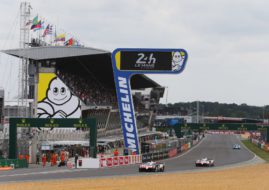Mercedes Benz CLR
When Mercedes Benz CLR race car was announced it looked like there isn’t anything that could go wrong and that the new car is a clear winner. However, the CLR did get the front page of the news magazines but not in the way Mercedes had planned it…

In 1998 Mercedes introduced a new race car build with latest technology and high ambitions, the CLR. It was designed to meet the LMGTP regulations and Mercedes wanted the new model to be the Le Mans winner in 1999. The company built three cars and tested them extensively. The specifications were impressive, the chassis being made of carbon fiber and aluminium with honeycomb monocoque, double wishbone suspension and mid-mounted, naturally aspirated V8 by AMG with 5,7 liters displacement and 600 bhp. During the period of preparation, all three cars traveled over 35.000 km through various tests.

At 1999 24 Hours of Le Mans, Mercedes was represented by three cars, No 4. driven by Jean-Marc Gounon, Marcel Tiemann and Mark Webber, No 5. driven by Christophe Bouchut, Peter Dumbreck and Nick Heidfeld and a No 6. driven by Franck Lagorce, Pedro Lamy and Bernd Schneider. It looked that everything is going great until Mark Webber had a horrifying accident flipping his car backwards during qualifying. Webber landed on his wheels and was not hurt and because there was no TV footage or reports, Mercedes kept quiet and continued with preparations for the race. The car No. 4 was repaired and joined by other two CLRs on the starting grid. During the warm up lap, the same incident repeated when Webber flipped again, almost at the same spot, near the Indianopolis curve. This time, he was going much faster and rose to nearly 10 meters above the track. This crash was seen on live broadcast and became top news before the race even began. The race started good for two Mercedes CLRs but in lap 75, the car No. 5 with Peter Dumbreck at the wheel took off track, flying to the trees and crashing. Luckly, Dumberck was not seriously hurt but everybody knew that something is very wrong with Mercedes’ aerodynamic. After the second crash, Mercedes retired the car No 6 fearing another incident and repeating the 1955 Le Mans tragedy.
Those crashes started investigations from FIA and Mercedes Benz and finished once promising career of CLR because Mercedes cancelled its racing program. There were a few possible reasons for the crash. The main was the front overhang of CLRs body was too long, enough to generate lift when the car is driven in area of lower wind pressure, behind another car. In combination with a bumps on the track or curbs it broke aerodynamic balance and caused the car to flip at a speed. After the incident, rules were changed for LMGTP category decreasing the allowable length of overhang. However, after everything, Mercedes ended up losing – its racing program was canceled, generated a lot of bad press and its greatest rival BMW won the 1999 24 Hours of Le Mans with a BMW V12 LMR race car.






